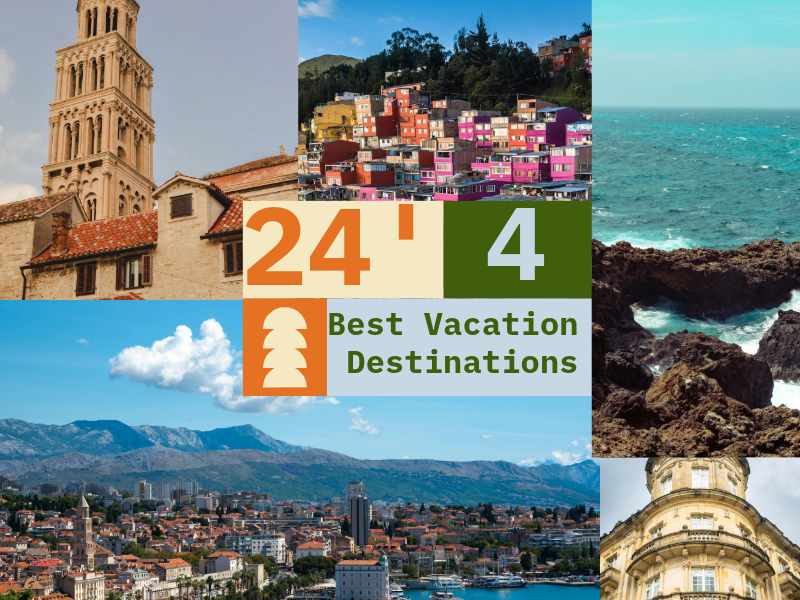Bogota, Columbia

At an elevation of 8,612 feet, Colombia’s capital Bogotá stands as a South American culture hub, and as a popular tourist destination for its vibrant architecture, serene mountainscapes, and unparalleled cuisine.
Food
Bogota is known for its metropolitan take on traditional Colombian dishes and vibrant nightlife, which attract tourists to its lively night bars and fine restaurants. Bogotas most iconic dishes include arepa, ajiaco, and empanadas. According to Nell Wulfhart of the New York Times, “The dazzling talents of Bogotanos, from culinary flourishes to chic shoemaking to visual art innovation, is on display like never before.”
Sightseeing
Bogota sightseeing is one of the most rewarding activities one can do on a trip to Colombia. With the Gold Museum and Plaza de Bolivar, the city values the history and dynasties that came before it while bolstering the vibrant nightlife that Bogotan clubs and discotheques are known for.
Split, Croatia

Known for the ruins of the palace of Roman emperor Diocletian, Split is the second-largest Croatian city residing on the Adriatic Sea. With a rich history and sparkling turquoise waters, the Split-Dalmatia area boasted 20.7 million overnight stays in the past year.
Food
While the mainland of Croatia has more Slavic and Turkish influences on c
cuisine, the coast, specifically the Dalmatia region is known for its food influenced by the Greek and Italian. For example, Croatian delicacies like Dalmatian prosciutto, Black Risotto, and Fritules are known for their Slavic take on Italy and Greece’s palette. Split is also known for its incredible seafood with its octopus pasta, Ston oysters, and Buzara, a muscle dish cooked in white wine and parsley.
Sightseeing
Once a center of commerce in the Byzantine Empire, Split is home to embellishments and structures dating back to the Renaissance, Medieval, and Baroque periods. As for the ancient aspects of the city, Diocletian’s palace is not thought of as a museum or a preserved morsel of ancient history, but rather a city center. For example, shops occupy the Roman arcades, the court is a popular meeting place, and the main market is outside the east gate of the palace.
Cairns, Australia
Known as the gateway to the Great Barrier Reef, Cairns is a tropical city in North Queensland and is the center of Australia’s indigenous islander history. Just 20 minutes of a boat ride to the beginning of the reef, one of the world’s most intricate marine ecosystems is open for anyone to visit.

Food
The North Queensland region is a top world producer of bananas, mangoes, pineapples, wild-caught prawns, and reef fish. Cairns cuisine is a fusion of seafood with its Aussie cookout elements. With the Great Barrier Reef on their back doorstep, Cairns has some of the world’s most fresh seafood as everything is locally caught.
Sightseeing
Accounting for the proximity of the Great Barrier Reef to Cairns, this city is known for its adventurous activities, whether it’s swimming in a cage surrounded by reef sharks, underwater tours, or swimming with turtles, the reef truly presents itself as a once in a lifetime opportunity to bask in an underwater escapade unlike any other.
Laos
Laos’s rich culture dating back to the ancient kingdom of Lan Xang, is one of its attracting factors for its millions of visitors each year. Traversed by the Mekong River, and its mountainous regions, Laos provides an opportunity to revel in its stunning French colonial and pacific asian architecture, and then cannonball off the Kuang Si waterfalls!
Food
When dining in Laos, sticky rice is considered a staple food of its own, yet the country represents a fusion of Vietnamese food and French cuisine from when France reigned large portions of Indochina. No cuisine on the earth parallels the unique blend of cuisine in Laos, with spicy forest vines, sauteed river weeds, and pink rice wine accompanying many dishes.

Sightseeing
A few example of Laos’s attractions is the Pha That Luang Vientiane a gilded Buddhist temple in the centre of the city of Vientiane. It remains a popular monument for its priceless value and its symbolization of the power and glory of the Lan Xang Kingdom. In addition to the Buddhist temples, Laos caters its forests and rivers to tourists by opening designated areas to enjoy turquoise falls and springs, and areas not for the weak at heart, designed for rope swinging and hang gliding.










